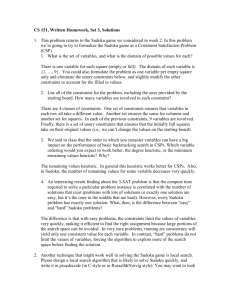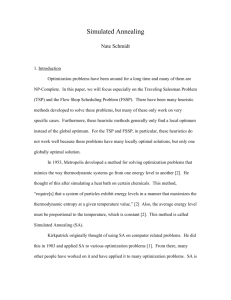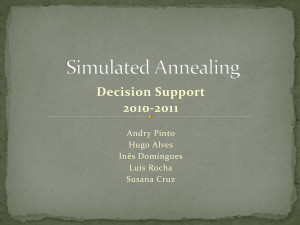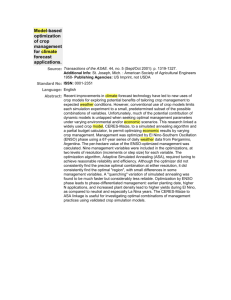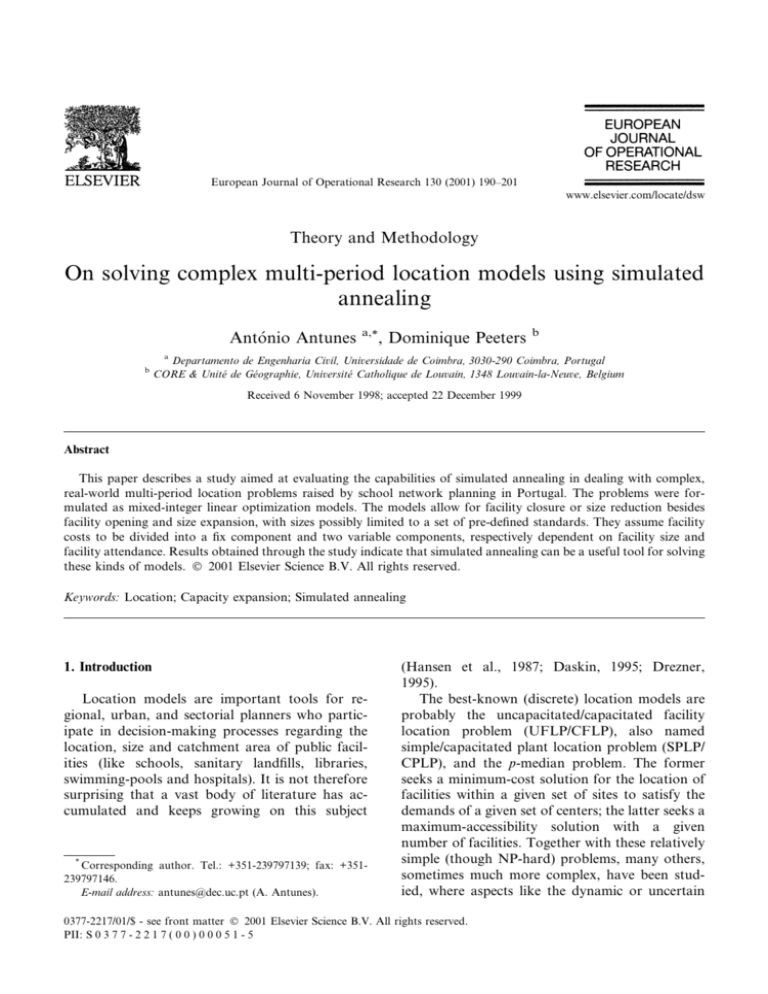
European Journal of Operational Research 130 (2001) 190±201
www.elsevier.com/locate/dsw
Theory and Methodology
On solving complex multi-period location models using simulated
annealing
Ant
onio Antunes
b
a,*
, Dominique Peeters
b
a
Departamento de Engenharia Civil, Universidade de Coimbra, 3030-290 Coimbra, Portugal
CORE & Unit
e de G
eographie, Universit
e Catholique de Louvain, 1348 Louvain-la-Neuve, Belgium
Received 6 November 1998; accepted 22 December 1999
Abstract
This paper describes a study aimed at evaluating the capabilities of simulated annealing in dealing with complex,
real-world multi-period location problems raised by school network planning in Portugal. The problems were formulated as mixed-integer linear optimization models. The models allow for facility closure or size reduction besides
facility opening and size expansion, with sizes possibly limited to a set of pre-de®ned standards. They assume facility
costs to be divided into a ®x component and two variable components, respectively dependent on facility size and
facility attendance. Results obtained through the study indicate that simulated annealing can be a useful tool for solving
these kinds of models. Ó 2001 Elsevier Science B.V. All rights reserved.
Keywords: Location; Capacity expansion; Simulated annealing
1. Introduction
Location models are important tools for regional, urban, and sectorial planners who participate in decision-making processes regarding the
location, size and catchment area of public facilities (like schools, sanitary land®lls, libraries,
swimming-pools and hospitals). It is not therefore
surprising that a vast body of literature has accumulated and keeps growing on this subject
*
Corresponding author. Tel.: +351-239797139; fax: +351239797146.
E-mail address: antunes@dec.uc.pt (A. Antunes).
(Hansen et al., 1987; Daskin, 1995; Drezner,
1995).
The best-known (discrete) location models are
probably the uncapacitated/capacitated facility
location problem (UFLP/CFLP), also named
simple/capacitated plant location problem (SPLP/
CPLP), and the p-median problem. The former
seeks a minimum-cost solution for the location of
facilities within a given set of sites to satisfy the
demands of a given set of centers; the latter seeks a
maximum-accessibility solution with a given
number of facilities. Together with these relatively
simple (though NP-hard) problems, many others,
sometimes much more complex, have been studied, where aspects like the dynamic or uncertain
0377-2217/01/$ - see front matter Ó 2001 Elsevier Science B.V. All rights reserved.
PII: S 0 3 7 7 - 2 2 1 7 ( 0 0 ) 0 0 0 5 1 - 5
A. Antunes, D. Peeters / European Journal of Operational Research 130 (2001) 190±201
nature of the decision context, as well as design
and organizational characteristics of particular
facilities, have been taken into account.
Location models are mixed-integer linear
programming models that, like any other models
of this kind, can be solved with three types of
algorithms: general (exact) algorithms, specialized
(exact) algorithms, and (specialized) heuristic algorithms. General algorithms, like `branch-andbound', can be used to solve to exact optimality
any (linear) facility location model, but they only
are ecient in handling small problems (though,
as shown by Ribeiro and Antunes (2000) much
larger ones than some years ago). Good commercial software packages, like GAMS/CPLEX
(Gams Development, 1996), XPRESS-MP (Dash
Associates, 1997) or MINTO (Nemhauser et al.,
1994), are now available for this purpose. Specialized algorithms can be used to solve large and
complex problems of the particular type under
consideration, exploiting their distinct mathematical structure. However, the best ones reported in the literature will normally require
arduous programming work before they can be
applied. Furthermore, it should be stressed here
that it is often quite dicult to adjust a specialized algorithm developed for a given problem,
to a slightly dierent problem. Heuristic algorithms also serve to solve large and complex
problems, and the corresponding software is
much easier to develop. However, they are not
exact, in the sense that they only guarantee a
local optimum, not necessarily close to the global
optimum.
The whole ®eld of location modeling started to
grow in the early 60s, led by authors like Kuehn
and Hamburger (1963), Feldman et al. (1966), and
Teitz and Bart (1968). These authors proposed
heuristics of a particular type, known as local
search heuristics. Another kind of heuristics that
may be used to solve location models became
popular only recently, in the 80s, under the name
of modern (or threshold) search heuristics. For a
survey, see Reeves (1993) or Aarts and Leenstra
(1997). Simulated annealing, the method dealt
with here, belongs to this family of heuristics, together with tabu search, genetic algorithms and
neural networks.
191
This paper describes a study aimed at evaluating the capabilities of simulated annealing in
dealing with complex, real-world multi-period location problems raised by school network planning in Portugal. The second section contains a
statement of the problem to be solved, and its
formulation as a mathematical model. The third
presents a detailed explanation about the approach adopted to solve it, before it was decided to
apply simulated annealing. Then follows a section
describing the criteria used to generate the partly
random problems on which the solution methods
were tested. The ®fth section presents the general
principles of simulated annealing and the main
features of their implementation to our model. The
sixth gives essential information about the results
obtained in four real-world applications of the
model. The ®nal section summarizes the main
conclusions of the study and indicates some directions for future research.
2. Location model
In 1986, the Portuguese Government decided to
extend elementary education from 6 to 9 years.
Such a decision could not be put into eect without a very signi®cant expansion of infrastructure,
and a program to know where, with what size and
when should schools be built. Of course, in formulating the program, attention had to be paid to
the fact that, in the future, given the `fertility crisis'
that is aecting Portugal, as much as the whole
Western World, education demand tends to be
drastically reduced.
Research on the kind of dynamic problems we
were interested in was initiated by Roodman and
Schwartz (1975, 1977), and has received several
relevant contributions since then, particularly
from authors like Van Roy and Erlenkotter (1982),
Fong and Srinivasan (1981), Jacobsen (1990), and
Shulman (1991). Further work speci®cally addressing school location problems has been done
by Viegas (1987) and Greenleaf and Harrison
(1987). However, to the best of our knowledge, the
literature does not report work done with models
accounting for facility closure and capacity reduction in addition to facility opening and
192
A. Antunes, D. Peeters / European Journal of Operational Research 130 (2001) 190±201
capacity expansion, particularly when capacity
and assignment decisions and costs are dissociated.
In circumstances such as those found in Portugal
(capacity shortage with decreasing demand), these
features are of crucial importance.
This led us to develop a multi-period model
aimed at ®nding the minimum discounted cost
solution for the evolution of a set of facilities
through a given planning horizon in order to meet
the demands for the corresponding services. The
decisions to be made consist of opening new facilities, and expanding, reducing or closing existing
facilities. The model is as follows:
min C
XX X
j2J
X X
k2K m2M
cvxjkm xjkm
k2K m2M
X X
k2K m2M
ÿ
ÿ
ykm
cfkm ykm
ÿ
ÿ
cvzkm z
km ÿ zkm ;
1
subject to
X
k2K
X
j2J
xjkm 1;
8j 2 J; m 2 M;
2
ÿ
ÿ
ÿ
ÿ
ujm xjkm 6 qk0 ykm
ykm
q z
km ÿ zkm ;
8k 2 K; m 2 M;
6 q:z
qmin ÿ qk0 ykm
km 6 qmax ÿ qk0 ykm ;
k
k
8k 2 K; m 2 M;
ÿ
q:zÿ
km 6 qk0 ÿ qmin ykm ;
k
ykm
ÿ
ykm
6 1;
6 ykm
;
yk;mÿ1
ykm
6 yk;mÿ1
;
ÿ
ykm
ÿ
6 yk;mÿ1
;
z
k;mÿ1 6 zkm ;
4a
1
8k 2 K ; m 2 M;
8k 2 K; m 2 M;
7a
1
7b
8k 2 K ; m 2 M n f1g;
8k 2 K ; m 2 M n f1g;
8k 2 K; m 2 M n f1g;
1
k2K 0
X
ÿ
z
evzkm z
km
k;mÿ1 6 bm
8k 2 K ; m 2 M n f1g;
efkm ykm
ÿ yk;mÿ1
k2K
6
1
6 zÿ
km ;
4b
5
8k 2 K 0 ; m 2 M n f1g;
zÿ
k;mÿ1
X
3
8m 2 M;
8
9
10
xjkm 6 0;
8j 2 J; k 2 K; m 2 M;
ÿ
; ykm
2 f0; 1g;
ykm
ÿ
zkm ; zkm P 0 and
k 2 K; m 2 M;
integer 8k 2 K; m 2 M;
where J is the set of centers
j 1; . . . ; J , K the
set of sites
k 1; . . . ; K, K 0 the set of initially
closed sites, K 1 the set of initially opened sites, M
the set of periods
m 1; . . . ; M, xjkm the fraction
of users from center j assigned to a facility located
1 if an expanding faat site k in period m, ykm
0 othcility is located at site k in period m; ykm
ÿ
erwise, ykm 1 if a reducing facility is located at
ÿ
0 otherwise, z
site k in period m; ykm
km the accumulated capacity expansion of the facility located at site k up to period m, zÿ
km the accumulated
capacity reduction of the facility located at site k
up to period m, cvxjkm the discounted attendancevariable cost of a facility located at site k in period
m per user of center j (includes transport costs),
cfkm the discounted ®xed cost of a facility located
at site k in period m (for initially opened facilities it
includes the cost associated with a capacity of qk0 ),
cvzkm the discounted capacity-variable cost increase (or decrease) of expanding (or reducing) a
facility located at site k in period m, ujm the
number of users located at center j in period m, qk0
the initial capacity of the facility located at site k, q
the capacity of a module, q maxk
Pqk0 the maximum capacity of a facility located at site k,
q mink
6qk0 the minimum capacity of a facility
located at site k, efkm the ®xed setup expenditure
for a facility to be located (or expanded) at site k in
period m, evzkm the capacity-variable setup expenditure for a facility to be located at site k in period
m, and bm is the budget for period m.
This is a complicated mixed-integer linear programming model, to which we gave a name in the
tradition of location analysis: `dynamic modular
capacitated facility location problem' (DMCFLP)
model.
The geographical landscape assumed by the
model is the one normally used in (discrete) location modeling. Demand for facilities is assumed to
be concentrated in points named centers, which
may represent regions, municipalities, towns or
neighborhoods. Supply of facilities is assumed to
be possible at points named sites, which represent
either any one of the above geographical entities or
A. Antunes, D. Peeters / European Journal of Operational Research 130 (2001) 190±201
determined plots of land. The facilities are assumed to be composed of a ®xed part and a variable number of modules of given ®xed capacity.
For schools, the module may be either one classroom or a group of classrooms.
Function (1) expresses the objective of minimizing the total discounted (socio-economic) costs
of a set of facilities. Facility costs are divided into
three parts: ®xed costs, capacity-variable costs
proportional to the number of modules, and attendance-variable costs proportional to the number of users, a signi®cant part of which will
normally consist of transport costs. With regard to
existing facilities, initial capacity-variable costs are
taken as ®xed costs, which explains the minus sign
applied to variables zÿ
km .
Constraints (2) ensure that, in each period, the
demand of any center will be met by some facility or
facilities. Constraints (3) guarantee that the capacity of each facility in each period, resulting from
adding the initial capacity to the accumulated capacity expansion occurred up to the period, will be
large enough to meet the demand assigned to it.
Constraints (4a) and (4b) ensure that maximum and
minimum capacity limits, de®ned to avoid or exploit technical and economic scale advantages or
disadvantages, will be taken into account at both
expanding or reducing facilities. Constraints (5)
guarantee that capacities may either be expanded or
reduced, but not both. Constraints (6) ensure that
facilities opened at initially closed sites, once
opened, will remain open. Constraints (7a) and (7b)
guarantee that facilities closed at initially opened
sites, once closed, will remain closed. Constraints
(8) ensure that the capacity of expanding facilities
will never decrease. Constraints (9) guarantee that
the capacity of reducing facilities will never increase. Finally, constraints (10) ensure that the
budget constraints de®ned for each period will be
satis®ed. In these constraints, the variables z
k0
should be set equal to qk0 , and the variables yk0
should be set equal to 0.
3. Solution approach
The model introduced in the previous section is
quite a dicult one, something that we readily
193
understood after we tried, and failed, to solve
some partly random 10-center 10-site 3-period
problems using packages like SCICONIC,
XPRESS-MP and CPLEX (early versions). Section 4 describes how the problems were generated.
Our ®rst attempt to overcome these diculties
involved a ÔmyopicÕ approach, consisting of solving the ®rst-period problem without taking into
account future-period demands, and then solving
the second-period problem given the optimum facility set identi®ed for the ®rst-period problem,
and so forth. The results obtained using this approach, compared with those given by a ÔpanoramicÕ approach (within which short-term
planning decisions would also re¯ect the long-term
expected evolution for demand), were quite good
on many occasions, though not in the presence of
severe capacity shortage and rapidly decreasing
demand. (Antunes, 1994, pp. 57±68.) This was
precisely the situation found in many Portuguese
regions when it was decided to extend elementary
education.
The idea of using simulated annealing emerged
when we realized that it would be relatively simple
to apply this method to our model, and once we
understood that our eorts to develop dual-based
and lagrangean relaxation specialized methods
were unlikely to be successful. Of course, we knew
that tests on complex, large-constrained models
had sometimes failed to meet expectations, but
there were not many other promising options open
to us.
Before applying simulated annealing to the
model, we decided to try it on a simple location
model, UFLP (Krarup and Pruzan, 1983; Cornuejols et al., 1990), to see how it would compare
with ADD and ADD + INTERCHANGE, two
fast, well-known local search heuristics. ADD assumes all the sites to be initially closed and, in
successive iterations, opens the facility which allows the best decrease in costs, until no further
cost reduction is possible. INTERCHANGE
works upon ADD and, in successive iterations,
chooses the capacity transfer, from open to closed
sites, which allows the best decrease in costs, once
again until no further cost reduction is possible.
The results obtained with a good choice of
annealing parameters (this concept is clari®ed in
194
A. Antunes, D. Peeters / European Journal of Operational Research 130 (2001) 190±201
Section 5) in solving a representative sample of
partly random problems are summarized in Tables
1 and 2. The comparison with ADD was encouraging about the prospects of annealingÕs capabilities, because the solutions found were clearly
better. But it was the comparison with
ADD INTERCHANGE, often regarded as being a good heuristic, that ®nally convinced us of its
possibilities. In fact, for a set of small
20-center 20-site problems, the annealing algorithm (called ANNEAL in abbreviated form)
produced worse results and took longer on average
than ADD INTERCHANGE. But large
80-center 80-site problems were solved better
and faster, indicating the aptness of simulated
annealing for dealing with problem size.
4. Random problems
As mentioned in the previous section, alternative methods were tested using partly random
problems, i.e., problems including both deterministic and stochastic elements. There was no other
way of building a representative sample, as multiperiod location problems are relatively rare in the
literature.
The deterministic part of problem data included the territory geometry (a square of 100 100
length units), the number of centers, sites and pe-
riods, and classroom capacity (25 students). It also
included cost data. Setup costs were assumed to
consist of a ®xed part and a variable part, respectively, equal to 10 monetary units
l and
10 l per classroom. Operating costs were also assumed to consist of a ®xed part and a variable
part, respectively equal to 10 l per planning period of 5 years and 17 l per classroom per period.
Transport costs were taken to be 0:08 l per period
per student. A discount rate of 40% per period
(equivalent to 7% per year) was taken to convert
setup costs to a per period basis. These particular
®gures were the same as those to be used later in
solving real-world problems of school network
planning.
The stochastic part of problem data included
the coordinates of centers and sites, the number of
users in each center and its evolution through time,
the location and capacity of existing facilities, and
the maximum capacity of new facilities. The coordinates of centers and sites were assumed to be
random integers uniformly distributed between 0
(zero) and 100. Thus, centers and sites were located inside or on the border of a 100 100
square, with integer coordinates. The users in each
center were assumed to be a random integer uniformly distributed between 0 (zero) and 200. This
number was taken to change through time according to the combined eect of a random global
growth rate (varying from problem to problem)
Table 1
Comparison between ADD and ANNEAL results for UFLP problems
Problem size
(centers sizes)
ANNEAL better
than ADD
ADD equal to
ANNEAL
ADD better than
ANNEAL
Computing time
ANNEAL/ADD
20 20
40 40
80 80
24
58
103
89
50
4
12
17
17
6.31
3.27
1.87
Table 2
Comparison between ADD + INTERCHANGE and ANNEAL results for UFLP problems
Problem size
(centers sizes)
ANNEAL better
than ADD+
ADD + better
than ANNEAL
ADD+ equal to
ANNEAL
Computing time
ANNEAL/ADD+
20 20
40 40
80 80
5
14
50
106
84
38
14
27
37
1.87
1.06
0.64
A. Antunes, D. Peeters / European Journal of Operational Research 130 (2001) 190±201
and a random local growth rate (varying from
center to center). Both rates were taken to follow a
uniform distribution between )10% and 10% per
period. Existing facilities were assumed to be located near the largest centers with probability
proportional to center size. The capacity of these
facilities was taken to be equal to a randomly selected number of classrooms, such that they would
be able to accommodate a maximum of 4=3 and a
minimum of 2=3 of the users living in the nearest
center. The maximum capacity of new facilities
was taken to be equal to a randomly selected
number of modules, equal for all facilities, and
such that global capacity would not exceed the
total number of users multiplied by two.
The problems generated using these rules were
quite `realistic', at least with respect to the school
network planning conditions encountered in Portugal.
5. Annealing implementation
After being successfully applied to the traveling
salesman problem and other classic optimization
problems, simulated annealing became widely
known in the OR community.
The basic ideas behind the annealing algorithm
are brie¯y described below. For a detailed presentation of the subject, see Dowsland (1993) or
Aarts et al. (1997).
Suppose the cost of the current state or solution
S of a given system is C
S. A solution to a (discrete) public facility location problem is de®ned by
the locations of open sites, the capacity of the
corresponding facilities and the assignment of users to facilities. It can be shown that if the transition of the current state to a randomly selected
neighboring solution S 0 , with cost C
S 0 , is made
according to some appropriate choice criteria, the
system will tend towards the global least cost solution as the number of transition attempts increases.
The choice criterion most commonly used is the
Metropolis criterion, built upon the BolzmannGibbs distribution, according to which S would be
selected with probability given by
p min 1; exp
DC
ÿ
h
195
:
In this expression DC C
S 0 ÿ C
S and h is
the temperature of the system, a parameter whose
value may decrease during the annealing process.
The function describing the evolution of temperature during the annealing process is known as the
cooling schedule.
Notice that according to the Metropolis criterion solutions leading to cost decreases will always
be selected
p 1, while solutions leading to cost
increases will be selected with larger probability at
the beginning of the annealing process, especially if
increases are small.
In general terms, the annealing algorithm consists of the following steps:
1. Choose S1 fS1 : initial solutiong
2. Choose h1 fh1 : initial temperatureg
3. Choose hf fhf : final temperatureg
4. j ! 0
5. Repeat
6. j
j1
ÿ ÿ 7. Choose at random Sj0 2 N Sj fN Sj :
neighborhood setg
8. Choose at randomp 2 0; 1;
C
Sj0 ÿC
Sj
9. If p 6 min 1; exp ÿ
hj
Sj0
Then Sj1
Else Sj1
Sj
10. Choose hj1 6 hj
Until hj1 < hf
11. End
Any practical implementation of simulated annealing requires two basic issues to be decided: the
generation of candidate solutions; and the attributes of the cooling schedule.
The generation of candidate solutions is accomplished, in our implementation, through the
procedure described in Fig. 1.
First, a site and a period are selected at random,
with all the sites and periods having the same
probability of being chosen. If the site is closed, it
will become open, receiving a minimum capacity
facility. When the site is open, it will go through a
feasible transformation selected at random. This
transformation may either consist of adding a new
module to the existing facility, transferring a
196
A. Antunes, D. Peeters / European Journal of Operational Research 130 (2001) 190±201
Fig. 1. Generation of candidate solutions for DMCFLP problems.
module to another facility (also selected at random), or dropping a module. For a facility at
minimum capacity, the suppression of a module
will naturally imply facility closure.
Second, if the site is open, the capacity sequence
of facilities where modules have been added or
dropped is analyzed and possibly adjusted, to ensure that the monotonic rules applying to the
evolution of facilities are observed. The adjustments are made towards the front, starting from
the initial period. For example, considering a 3-
period problem, if the current capacity sequence
for a facility is fz q; z; zg and the selected
transformation consists of suppressing a module in
the second period, capacity in this period would
become equal to z ÿ q (where z represents a given
capacity and q stands for the capacity of a module). Hence, we would have the sequence
fz q; z ÿ q; zg. To avoid this non-monotonic sequence, capacity in the third period has to be set at
z ÿ q. Therefore, the candidate capacity sequence
in the site would be fz q; z ÿ q; z ÿ qg. Fig. 2
A. Antunes, D. Peeters / European Journal of Operational Research 130 (2001) 190±201
197
Fig. 2. Capacity adjustments in 3-period problems.
describes the capacity adjustments consecutive to
several possible changes in the second period of a
3-period problem. Similarly, in a 4-period problem, if the current capacity sequence for a facility
is fz q; z; z; z ÿ qg and the selected transformation consists of adding a module in the third
period, capacity in this period would become
equal to z q. Hence, we would have the sequence fz q; z; z q; z ÿ qg. To avoid this non-
monotonic sequence, capacity in the third period
has to be set back at z (i.e., the change would be
rejected).
Finally, compliance with budget constraints is
checked. If the candidate solution is accepted, the
cost of the solution is calculated after assigning the
users to the facilities by solving transportation
problems (one for each period). The tree-indexing
method employed for this purpose is explained in
198
A. Antunes, D. Peeters / European Journal of Operational Research 130 (2001) 190±201
Jacobsen (1978). Otherwise, a new candidate solution is generated.
The attributes of the cooling schedule were
chosen following the principles adopted by Johnson et al. (1989) in their annealing algorithm for
the graph partitioning problem. Those authors
de®ned a schedule involving four parameters: the
initial temperature, h1 ; the temperature length, k;
the cooling rate, c; and the stopping number, r.
The initial temperature de®nes the rate at which
candidate solutions with cost x% higher than the
cost of the initial solution are retained. The temperature length is the minimum number of candidate solutions to be tried at each temperature. If
the algorithm is unable to ®nd at least one better
single solution or a better average solution, the
temperature is decreased. The cooling rate is the
rate at which temperature is decreased. The stopping number is the maximum number of temperature reductions that may occur without ®nding
any solution improvements. When this number is
reached the system becomes ``frozen'', and the
annealing process reaches the end. The links between the four parameters and the way they interact are shown in Fig. 3.
On the basis of a detailed empirical study carried out on the UFLP and the DMCFLP, described in detail in Antunes (1994, pp. 97±110,
114±124), we chose the following parameters:
· h1 0:13 C1 , where C1 is the cost of a randomly chosen feasible initial solution (this
means that solutions with a cost 30% higher
than the initial solution cost will be chosen with
a probability of approximately 10%),
· k 3KM (K is the number of sites and M is the
number of periods),
· c 0:3,
· r 6.
In order to test our implementation of simulated annealing (ANNEAL), we compared the
corresponding solutions with the solutions given
by branch-and-bound (B±B) for a set of 50 random DMCFLP problems. The package XPRESSMP was used to calculate the B±B solutions, because some preliminary tests indicated that this
package would be more ecient than GAMS/
CPLEX. The comparison was made on the basis of
small 6-center 6-site 3-period problems, the
Fig. 3. The cooling schedule for the annealing process.
maximum size we were able to handle within reasonable computational eort.
The results are summarized in Table 3. Average
annealing solutions taken for 5 random seeds (i. e.,
5 dierent sets of random numbers) were inferior
to the B±B solutions in 36 out of 50 problems, but
only in 17 was ANNEAL unable to ®nd the optimum B±B solution. However, it came close to the
optimum solution in all these 17 problems, as the
dierence was always less than 1%. In the remaining 33 problems, ANNEAL was at least as
ecient as B±B. The use of Ôat leastÕ is justi®ed
because, surprisingly, on 9 occasions, ANNEAL
gave better solutions than B±B (the XPRESS-MP
implementation of it), something that would be
impossible if the corresponding optimum were
really exact, as we expected them to be. According
to the investigation we made, this unexpected result is associated with the default tolerances assumed by XPRESS-MP. Smaller tolerances would
probably lead to better solutions, but we were not
A. Antunes, D. Peeters / European Journal of Operational Research 130 (2001) 190±201
199
Table 3
Comparison between ANNEAL and B±B results for DMCFLP problems
Solutions for ®ve
random seeds
Dierence in cost between ANNEAL and B±B solutions (%)
<)1
[)1, 0[
0
]0, 1]
>1
Worst
Average
Best
1
4
4
5
4
5
6
6
24
21
34
17
17
2
0
able to complete the B±B search procedure within
reasonable computational eort (and even if we
were, we could not be sure they were true optimum). This made us decide to keep the defaulttolerance solutions as a reference, and to see them
as the best aordable B±B solutions.
These ®ndings were quite encouraging especially because the computational eort required to
run ANNEAL was about 10% of the eort required by B±B. Furthermore, the computing time,
which averaged 530 seconds on a 40 MHz Macintosh Quadra 700, showed only limited ¯uctuation from problem to problem, their coecient of
variation being equal to just 21.5%.
6. Real-world applications
Following the results described in the previous
section, ANNEAL was used to solve four facility
location problems raised by school network planning in PortugalÕs Centro Region. These problems,
and the context within which they arose, are described elsewhere (Antunes and Peeters, 2000).
Therefore, we only include here the essential information about their data and results.
Three of the problems were de®ned for the
secondary school (escolas secund
arias (ES)) networks of the sub-regions of Baixo Vouga, Baixo
Mondego and Pinhal Litoral. The other one was
de®ned for the elementary school (escolas b
asicas
(EB)) network of the municipality of Leiria, which
is part of the Pinhal Litoral sub-region. The location of these four geographical areas is depicted
in Fig. 4. All the problems were built considering
three periods, representing the short-, the mediumand the long-term.
The ES problems were smaller in size, ranging
from the 5-center 12-site
3-period problem
Fig. 4. Location of real-world applications.
de®ned for the Pinhal Litoral, to the 8 20
and the 12 23 problems de®ned, respectively,
for the Baixo Mondego and the Baixo Vouga
problems. In these problems, each center represented a municipality, and each site represented a
location within a municipality, either where facilities existed when the planning process began,
or where facilities could be located during the
process. Comparatively, the EB problem was
quite large, involving 29 centers and 38 sites, with
both centers and sites corresponding to communities (the smallest Portuguese administrative
unit).
200
A. Antunes, D. Peeters / European Journal of Operational Research 130 (2001) 190±201
The Baixo Mondego problem was studied ®rst,
because it was used as a basis for adjusting the
algorithm to certain speci®c needs of real-world
applications (for instance, the needs associated
with the presence of existing facilities built according to outdated maximum and minimum capacity requirements). This problem was solved 20
times (20 dierent random seeds), using a 200
MHz Macintosh Performa 6400. The 20 runs gave
six dierent solutions. The best solution occurred
six times. The dierence in cost between the best
and the worst solutions was 1.7%. It should however be said that the short-term intervention corresponding to the best solutions was obtained 14
times. This is an important fact to emphasize because, within a cyclical planning framework, the
short-term decisions undoubtedly are the most
relevant. Medium- and long-term decisions, which
are not to be implemented immediately, can be
changed later if necessary. As shown in Table 4,
the number of candidate solutions investigated by
ANNEAL was on average 5310, with a maximum
of 8100 and a minimum of 2700. The average
number of accepted solutions and solution improvements was 2740 (51.60%) and 72 (1.36%).
The computing time was on average 170 seconds,
with a maximum of 257 seconds (i.e., always less
than ®ve minutes).
The Pinhal Litoral, Baixo Vouga and Leiria
problems were solved ®ve times each. The main
(relative) dierences with regard to the Baixo
Mondego problem occurred with computing time.
The Pinhal Litoral problem took on average 43
Table 4
Characteristics of the annealing process for the Baixo Mondego
problem
Characteristic
Maximum
Average
Minimum
Number of
candidate
solutions
Number of
accepted
solutions
Number of
solution
improvements
Computing
time (s)
8100
5310
2700
3885
2740
1716
111
72
53
257
170
86
seconds, with a maximum of 58 seconds (i.e., less
than one minute). The computing time for the
Baixo Vouga problem was on average 717 seconds,
with a maximum of 1047 seconds (i.e., more than
15 minutes). The Leiria problem took on average
299 minutes to solve, with a maximum of 583
minutes (i.e., almost 10 hours). In spite of the large
eort needed to compute the solutions for this
problem, in one of the ®ve runs a better solution
was found through inspection, interchanging open
and close sites.
7. Conclusion
The study described in this paper shows that
simulated annealing may be a good resort when
solving complex mid-size multi-period location
problems like those raised by school network
planning in Portugal. The corresponding algorithms are really easy to develop, and easy to
adapt to new application conditions. The trade-o
between cost and quality of solution in our case
studies was quite interesting.
The study also revealed the limitations of simulated annealing when dealing with large-size
problems. However, it must be said that our algorithm could be improved in respect to a few
points. We used a relatively simple algorithm. It
could be made more sophisticated, for instance
through the introduction of penalty schemes or
tabu lists commonly used today within modern
search heuristics. Moreover, some elementary
procedures could be improved. One such improvement would be achieved by solving transportation problems more quickly, using solutions
found in previous iterations. As the algorithm will
normally involve solving thousands of transportation problems, the impact of this improvement
will be considerable. In the future, we will direct
part of our research activities to this kind of issues.
Acknowledgements
The authors acknowledge the valuable critiques
and suggestions received from Henri Zoller and
Laurence Wolsey during the preparation of the
A. Antunes, D. Peeters / European Journal of Operational Research 130 (2001) 190±201
Ph.D. thesis upon which this paper is based. The
®rst author also acknowledges the support received from the Fundacß~
ao Calouste Gulbenkian
and Universidade de Coimbra while he was in
Louvain.
References
Aarts, E., Leenstra, J. (Eds.), 1997. Local Search in Combinatorial Optimization, Wiley, Chichester, pp. 91±120.
Aarts, E., Korst, J., Laarhoven, P., 1997, Simulated annealing.
In: Aarts, E., Leenstra, J. (Eds.), Local Search in Combinatorial Optimization, Wiley, Chichester, pp. 91±120.
Antunes, A., 1994. De la plani®cation optimale de lÕequipement
scolaire (on optimal planning of school networks). Ph.D.
Thesis, Universite Catholique de Louvain, Belgium.
Antunes, A., Peeters, D., 2000. A dynamic optimization model
for school network planning. Socio-Economic Planning
Sciences (forthcoming).
Cornuejols, G., Nemhauser, G., Wolsey, L., 1990. The uncapacitated facility location problem. In: Mirchandani P.,
Francis, R. (Eds.), Discrete Location Theory, Wiley, New
York, pp. 119±171.
Dash Associates, 1997. XPRESS-MP Release 10 User Guide
and Reference Manual.
Daskin, M., 1995. Network and Discrete Location, Wiley, New
York.
Dowsland, K., 1993. Simulated annealing. In: Reeves, C. (Ed.),
Modern Heuristic Techniques for Combinatorial Problems.
Wiley, New York, pp. 20±69.
Drezner, Z. (Ed.), 1995. Facility Location. Springer, New York.
Feldman, E., Lehrer, F., Ray, T., 1966. Warehouse location
under continuous economies of scale. Management Science
12, 670±684.
Fong, C., Srinivasan, V., 1981. The multi-region dynamic
capacity expansion problem ± Part II. Operations Research
29, 801±816.
GAMS Development Corporation, 1996. GAMS/CPLEX 4.0
User Notes.
Greenleaf, N., Harrison, T., 1987. A mathematical programming approach to elementary school facility decisions.
Socio-Economic Planning Sciences 21, 395±401.
201
Hansen, P., Labbe, M., Peeters, D., Thisse, J.-F., 1987. Facility
location analysis. In: Lesourne, J., Sonnenschein, H. (Eds.),
Systems of Cities and Facility Location, Harwood, London,
pp. 1±70.
Krarup, J., Pruzan, P., 1983. The simple plant location model:
Survey and synthesis. European Journal of Operational
Research 4, 256±269.
Kuehn, A., Hamburger, M., 1963. A heuristic program for
locating warehouses. Management Science 9, 643±666.
Jacobsen, S., 1978. On the use of tree-indexing methods in
transportation algorithms. European Journal of Operational Research 2, 54±65.
Jacobsen, S., 1990. Multiperiod capacitated location models.
In: Mirchandani, P., Francis, R. (Eds.), Discrete Location
Theory, Wiley, New York, pp. 173±208.
Johnson, D., Aragon, C., McGeoch, L., Schevon C, 1989.
Optimization by simulated annealing: An experimental
evaluation ± Part I. Graph partitioning. Operations Research 37, 865±892.
Nemhauser, G., Savelsberg, M., Sigismondi, G., 1994. MINTO:
A mixed integer optimizer. Operations Research Letters 15,
47±58.
Reeves, C. (Ed.), 1993. Modern Heuristic Techniques for
Combinatorial Problems. Wiley, New York.
Ribeiro, A., Antunes, A., 2000. On solving public facility
location problems using general mixed-integer programming methods. Engineering Optimization 32 (4).
Roodman, G., Schwartz, L., 1975. Optimal and heuristic
facility phase-out strategies. AIIE Transactions 7, 177±184.
Roodman, G., Schwartz, L., 1977. Extensions of the multiperiod facility phase-out model: New procedures and
applications to a phase-in/phase-out problem. AIIE Transactions 9, 103±107.
Shulman, A., 1991. An algorithm for solving dynamic capacitated plant location problems with discrete expansion sizes.
Operations Research 39, 423±436.
Teitz, M., Bart, P., 1968. Heuristic methods for estimating the
generalized vertex median of a graph. Operations Research
16, 955±961.
Van Roy, T., Erlenkotter, D., 1982. A dual-based procedure for
dynamic facility location. Management Science 28, 1091±
1105.
Viegas, J., 1987. Short and mid-term planning of an elementary
school network in a suburb of Lisbon. Sistemi Urbani 1, 57±
77.




